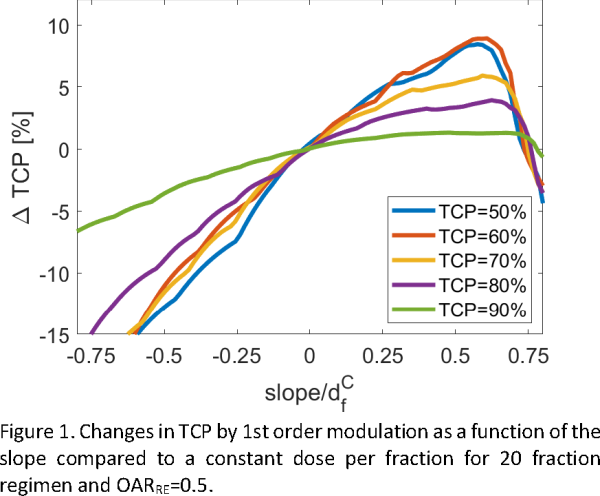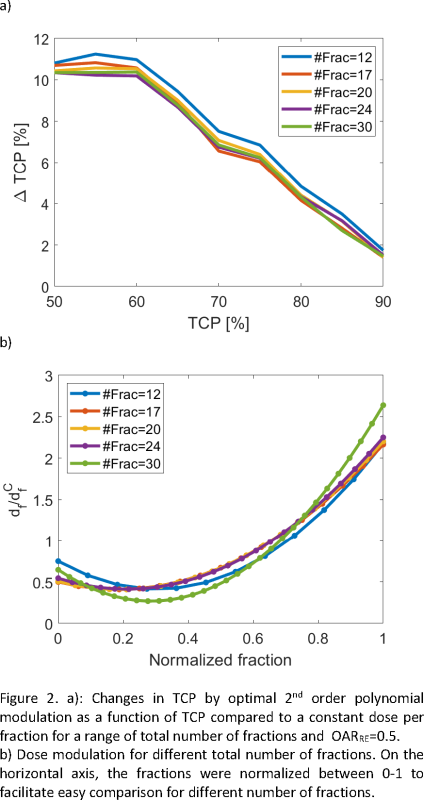Isotoxic temporal modulation of fraction size in conventional radiotherapy
PO-1761
Abstract
Isotoxic temporal modulation of fraction size in conventional radiotherapy
Authors: Jan-Jakob Sonke1, Joseph O. Deasy2, Jose Belderbos1, Monique de Jong3
1Netherlands Cancer Institute, Department of Radiation Oncology, Amsterdam, The Netherlands; 2Memorial Sloan Kettering Cancer Center, Department of Medical Physics, New York, USA; 3Netherlands Cancer Institute, Department of Radiaton Oncology, Amsterdam, The Netherlands
Show Affiliations
Hide Affiliations
Purpose or Objective
The dose
per fraction is typically constant in radiotherapy. The purpose of this study
was to explore the potential of isotoxic temporal modulation of dose per
fraction in NSCLC radiotherapy.
Material and Methods
We
implemented the TCP model of Jeong et al. [1] that dynamically simulates the
effect of proliferating tumor cells and radiation on tumors every 15 minutes.
It includes compartments for proliferating cells as well as intermediate and
highly hypoxic cells. The model accurately predicts local control for a wide
range of fractionation schemes. Subsequently we first calculated a constant
dose per fraction (dfC) yielding a range of TCPs [0.5,0.6,0.7,0.8,0.9]
for various number of fractions (F) ([12;17;20;24;30];5 fractions/week).
For each fractionation scheme, we then isotoxically optimized TCP by modulating
the dose per fraction. Fraction dose was modulated using a 1st and 2nd
order polynomials while keeping the EQD2 (α/β=3Gy) constant
for isotoxicity as follows:
df=a*(f/F)2+b*(f/F)+c
∑Ff=1 df*(OARRE* df
+3)/(2+3)=F*dfC*(OARRE* dfC +3)/(2+3),
where OARRE
is the ratio of the fraction dose that is received by the OAR assuming serial
organs for simplicity. OARRE
is assumed to be independent of df. Improvements in TCP were
quantified as a function of TCP, F and OARRE.
Results
Figure 1
illustrates the effect of a linear modulation on a treatment of 20 fractions
TCPs. It can be observed that negative slopes (d starting high, ending low)
reduce TCP, while positive slopes tend to increase TCP. Moreover, the effect
of modulation reduces with increasing TCP.
Figure 2a
depicts the optimal TCP for quadratic modulation. Improvements in
TCP maximize around 60% TCP and then decrease more or less linearly. Similarly,
the benefit of quadratic modulation versus linear was also bigger (3-5 pp) at
lower TCP than at higher TCP (0-2 pp). Very
little dependence on the number of fractions was observed. Figure 2b
illustrates the dose modulation, again showing little dependence on the number
of fractions.
As
expected, bigger improvements could be obtained in case of lower OARRE
corresponding to dose limiting toxicity related to OARs further away from the
tumor. Changes in TCP reduced by about 30% for OARRE=1 and increased
by about 60% for OARRE=0.25 compared to OARRE=0.5.
Conclusion
Considerable
improvements in TCP were observed using isotoxic temporal dose per fraction modulation
with lower dose per fraction at the start and increased toward the end over a
wide range of fractionation regimens. These results suggest that the
therapeutic window at the beginning of treatment is limited due to
radioresistant hypoxic cells and widens towards the end following
re-oxygenation. Tumor regression during treatment may be synergistic with such
temporal modulation and should be investigated further. Future work should also include parallel OAR
exposure and spatial heterogeneity of metabolism and hypoxia.
1Clinical Cancer Research, 2017.

